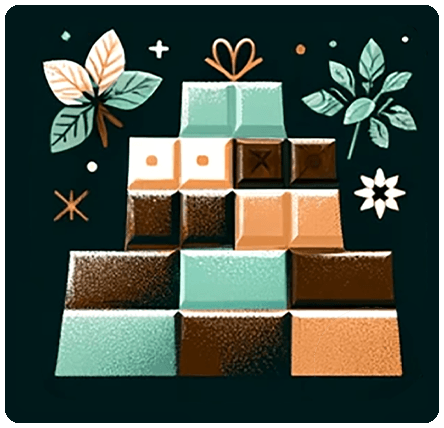Chocolate has a long, rich history. The popular narrative typically begins with the Aztecs meeting Spanish conquistador Hernán Cortés. Long story short, King Montezuma II and the Aztecs are conquered by the Spaniards, cocoa beans make their way across the Atlantic Ocean to Spain, and eventually chocolate is made and grows in popularity.
However, when we dig into the history books, the first discovery of chocolate is more nuanced and dates much further back, thousands of years in fact.
![]()
Let's Start with the Oldest Traces of Cocoa Beans
Chocolate is made from cocoa beans, which are harvested from Theobroma cacao trees. These trees thrive along or near the Equator, where the climate is hot and humid. So naturally, most of the oldest traces of cacao are found in and around the tropical regions of Latin America, Africa, and Asia.
Studying cacao, botanists have pinpointed the Amazon rainforest, specifically the northwest corner of the Amazon in South America, as the origin of the Theobroma cacao tree. Over time, archeological evidence shows that these trees in the wild were domesticated and farmed in Central America and other regions. How do we know this?
According to scientists, Theobroma cacao trees found in the Amazon exhibit the greatest genetic diversity at a cellular level. Studies show that genetic diversity was lost as trees were grown and harvested further away from the rainforest. In other words, this genetic diversity landslide occurred as wild cacao trees were domesticated, bred for desirable genetic qualities, and farmed for higher production.
With the epicenter being in the Amazon, it is highly probable that cocoa was discovered by a civilization that lived in or near the rainforest. Up until 2018, archeological findings could not support this theory.
For decades, the oldest evidence of an ancient civilization using cocoa beans was found more than 1200 miles away from the Amazon. Archeologists tested pottery at a site in Central America, specifically at the Puerto Escondido site in present-day Honduras. Researchers examined bowls, jars, and bottles found in tombs and burial sites. The vessels tested positive for theobromine, which is a substance found in cocoa beans. Using modern technology, the genetic samples taken from these vessels were about 3,600 years old, which means this civilization from Puerto Escondido used cocoa as early as 1500 BCE.
It was long believed that they were the first people to do so, but in 2018, archeologists uncovered another ancient society in the highlands of present-day Ecuador. This site, named Santa Ana-La Florida, was home to the Mayo-Chinchipe people. Geographically, it is located near the upper Amazon where Theobroma cacao trees first grew. Researchers collected 25 artifacts - stone mortars, ceramic bowls, bottles, and jars - and 21 of them tested positive for theobromine. Some of the vessels even had traces of starch grains and the presence of mitochondrial DNA that can only come from cocoa beans. These cocoa genetic samples taken from the Santa Ana-La Florida site in Ecuador were 5,300 years old.
This newest finding upended the previous timeline, pushing the discovery and usage of cocoa further back to 3200 BCE. However, there was no evidence to confirm whether or not these ancient civilizations used cocoa beans to make chocolate.
Chocolate Is Made for the First Time in Mesoamerica
To answer the question of how chocolate was discovered and made, we’ll need to travel north from South America and the Amazon rainforest to Mesoamerica - a historical region linked by culture that spanned from present-day central Mexico down to El Salvador and Honduras.
As we now know, Theobroma cacao trees originated in the Amazon. Following the evidence like breadcrumbs, cocoa beans were likely traded by land and sea routes from South America to other regions. Genetic signatures of Theobroma cacao show that the trees were domesticated and farmed as it made its way to Central America and as far north as Mexico.
In this region, which we’ll now refer to as Mesoamerica, there were several ancient civilizations that thrived between 1500 BCE to 1500 CE, namely the Olmecs and the Maya people. Archeologists have found that genetic analysis of artifacts, artwork, and even linguistics support the theory that these civilizations consumed cocoa beans and were the first to discover the process of making chocolate during this time period.
The Olmecs
The Olmecs are believed to be the first to domesticate the Theobroma cacao tree, as well as the first to ferment the pulp found in cacao pods into an alcoholic beverage.
The Olmecs were an ancient civilization that lived along the Gulf Coast of southern Mexico between 1600-350 BCE, and they were a major civilization within the great Maya Empire. Studying their ancient artifacts, the Olmecs revered Theobroma cacao and it played a significant role in the civilization’s mythology and religious beliefs. They called it kakawa, which is where we derive the word cacao.
As early as 1500 BCE, the Olmecs practiced fermenting, roasting, and grinding cocoa beans. In their culture, cocoa was primarily used for religious and funerary purposes. Eventually and likely from Mayan influence, the Olmecs made a concoction using fermented pulp from the cacao pods and ground cocoa beans mixed with spices for rituals and medicinal use.
It’s believed that the Olmecs passed on their knowledge and reverence for cocoa to the greater Maya Empire.
The Maya Empire
Although the greater Maya Empire was introduced to cocoa by the Olmecs, they perfected what they had learned, and even created a god of cacao. Archeological findings show that the Maya people invented the warm chocolate beverage that was widely consumed in Mesoamerica and built the first cocoa plantations. Recent discoveries confirmed that they were also the first to eat chocolate as food.
The Maya Empire was comprised of indigenous groups that lived in southern Mexico and the Yucatán Peninsula, Guatemala, Belize, El Salvador, and Honduras between 1800 BCE to 900 CE. At its peak, the empire had a population of two million people who resided in three main regions: the northern Maya lowlands in the Yucatán Peninsula; the southern lowlands of Guatemala, Mexico, Belize, and Honduras; and the southern Maya highlands of Guatemala.
Archeologists found that the Maya Empire was the first to ferment, dry, roast, and grind cocoa beans into a paste, and then this paste or chocolate liquor was mixed with a combination of water, cornmeal, chili, and other spices like vanilla, cinnamon, and even magnolia to make a frothy chocolate beverage in 450 BCE.
The Maya people harvested cocoa beans, which they called cacahuatl. Despite not having the ideal climate of the Amazon, they successfully set aside areas specifically to farm Theobroma cacao trees in Central America in 600 BCE. This supplied cocoa beans all across Mesoamerica. These became the first cocoa plantations, and the act of gathering cocoa beans and consuming chocolate at Mayan feasts and other significant ceremonies was immortalized in Mayan artifacts.
In 2001, archaeologists working with Mexico’s National Institute of Anthropology and History uncovered fragments from a 2,500-year-old plate - that would have been used in 600-500 BCE - in the northern Maya lowlands. The plate tested positive for theobromine and caffeine that is found in cocoa beans. This confirmed that the Maya people not only drank chocolate as a beverage, but they also made and ate chocolate possibly as a spice or sauce for food.
Chocolate Goes to Europe
With the decline of the Maya people in Mesoamerica, a new empire took its place. The Aztecs were a nomadic tribe that migrated to central and southern Mexico around 1100 CE. The Mesoamerican customs of processing cocoa beans and making chocolate beverages were passed onto the Aztecs. They named this drink xocolatl - xocolli meaning “bitter” and atl meaning “water,” which is the origin for the word chocolate.
The Aztecs eventually ruled this region until they were conquered by Hernán Cortés and his armies in 1521 CE. Nearly 4,700 years after cocoa beans were first discovered in the Amazon rainforest, cocoa beans and Mesoamerican chocolate recipes were introduced to Spain by Hernán Cortés. It would be another few hundred years before Europeans made the first chocolate bar.
Although the chocolate of Mesoamerica was a far cry from the chocolate that we enjoy today, the process of cultivating cacao trees and fermenting, roasting, and grinding cocoa beans into an edible chocolate experience was first discovered and practiced in Mesoamerica.
![]()












